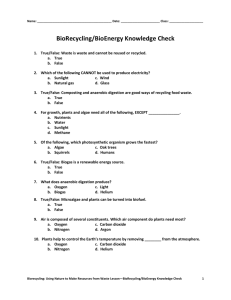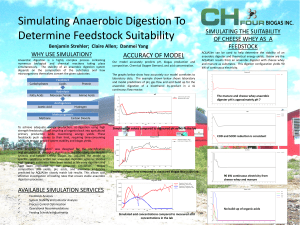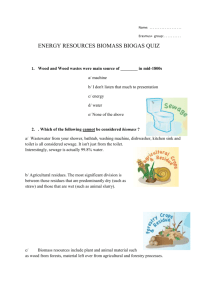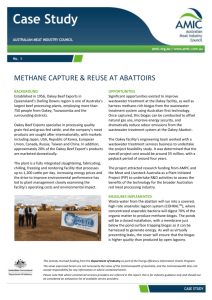The Business Case for Methane Capture & Reuse
advertisement
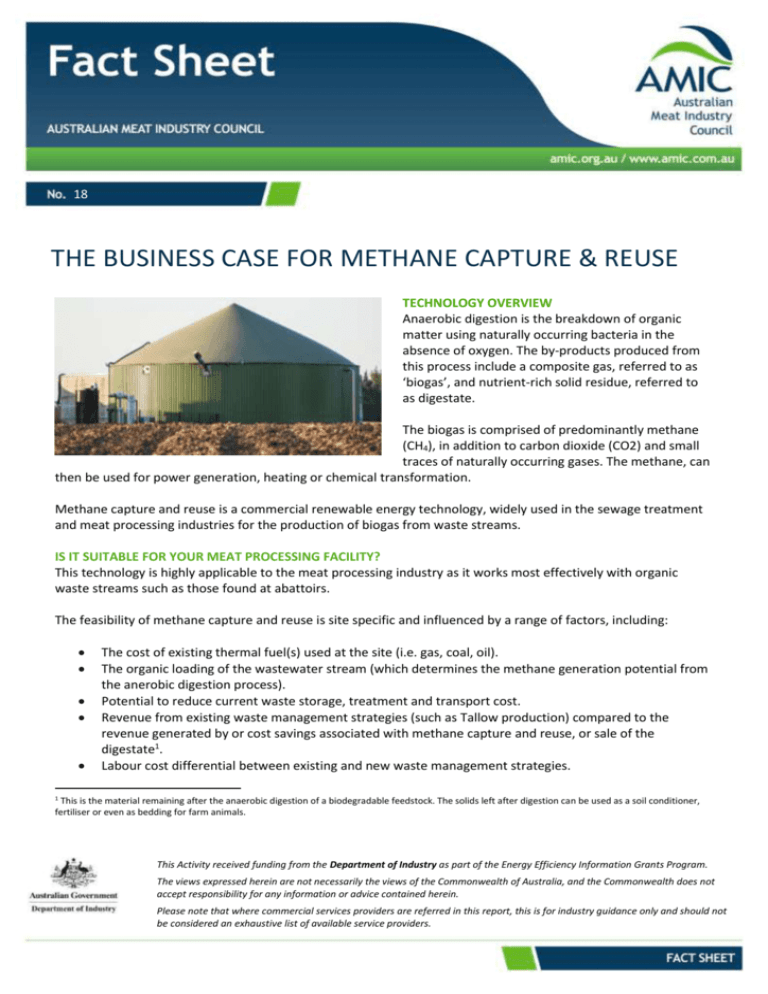
18 THE BUSINESS CASE FOR METHANE CAPTURE & REUSE TECHNOLOGY OVERVIEW Anaerobic digestion is the breakdown of organic matter using naturally occurring bacteria in the absence of oxygen. The by-products produced from this process include a composite gas, referred to as ‘biogas’, and nutrient-rich solid residue, referred to as digestate. The biogas is comprised of predominantly methane (CH4), in addition to carbon dioxide (CO2) and small traces of naturally occurring gases. The methane, can then be used for power generation, heating or chemical transformation. Methane capture and reuse is a commercial renewable energy technology, widely used in the sewage treatment and meat processing industries for the production of biogas from waste streams. IS IT SUITABLE FOR YOUR MEAT PROCESSING FACILITY? This technology is highly applicable to the meat processing industry as it works most effectively with organic waste streams such as those found at abattoirs. The feasibility of methane capture and reuse is site specific and influenced by a range of factors, including: The cost of existing thermal fuel(s) used at the site (i.e. gas, coal, oil). The organic loading of the wastewater stream (which determines the methane generation potential from the anerobic digestion process). Potential to reduce current waste storage, treatment and transport cost. Revenue from existing waste management strategies (such as Tallow production) compared to the revenue generated by or cost savings associated with methane capture and reuse, or sale of the digestate1. Labour cost differential between existing and new waste management strategies. 1 This is the material remaining after the anaerobic digestion of a biodegradable feedstock. The solids left after digestion can be used as a soil conditioner, fertiliser or even as bedding for farm animals. This Activity received funding from the Department of Industry as part of the Energy Efficiency Information Grants Program. The views expressed herein are not necessarily the views of the Commonwealth of Australia, and the Commonwealth does not accept responsibility for any information or advice contained herein. Please note that where commercial services providers are referred in this report, this is for industry guidance only and should not be considered an exhaustive list of available service providers. Non-economic benefits (i.e. odour control). Potential to benefit from carbon offsets. Methane has a global worming potential of 252 times that of carbon dioxide. Combustion transforms methane into heat and carbon dioxide. For some sites using biogas could be as simple as covering the existing anaerobic lagoon and using the captured gas to heat boiler water. In others though anaerobic digestion will require complex piping, a new digester and staff who can operate the system in a safe and effective manner. DEVELOPING THE BUSINESS CASE The main factors to consider when developing a business case for a methane capture and reuse project include: Assess the waste resource quality and quantity Determine the suitability of the site Compare the onsite energy demand with the biogas generation and utilisation potential of the anaerobic digestion system Estimate potential savings and cost Evaluation funding options ASSESS THE WASTE RESOURCE The anaerobic digester should be scaled to use the feedstock available from the site or nearby (i.e. from third parties). Without a continuous supply (e.g. daily or weekly) of the specific type of feedstock for which a facility is designed, the investment in an anaerobic digester may not be justified as it will be operating only part time. The waste stream can be modelled based on the head processed per day or week, and using industry standard factors for the waste and type of waste per head for different species. Determining the methane generation potential from abattoir waste can be complex as waste streams are non-homogeneous. The methane production potential influenced by various factors including the composition of the waste stream (i.e. relative portions of fats, oil, greases, cellulosic material, nutrients) and the volume of waste. DETERMINE THE SUITABILITY OF THE SITE A methane capture and reuse facility requires space for the production, storage, movement, handling and utilisation of biogas. Physical space constraints, as well as safety and environmental requirements should be considered. Planning guidelines for methane capture and reuse projects are evolving. A good starting point for methane capture and reuse projects is Pork Australia’s Code of Practice for On-farm Biogas Production and Use (Piggeries).3 A Biogas handling and reuse manual is under development and will be available from AMPC by mid2014. There are two main types of anaerobic systems; covered anaerobic lagoons (CALs) and in-vessel digesters (IVADs). In a CAL, biogas accumulates under an impermeable cover and is piped for processing. In IVADs, the digestion process can be more controlled, meaning the mixing rate, temperature and bacterial mix can be modified to enhance the process. A CAL is generally cheaper to construct, but requires more space and consideration for clean out of solids every few years due to build-up of sediment. COMPARE THE ONSITE ENERGY DEMAND WITH THE BIOGAS GENERATION AND UTILISATION POTENTIAL OF THE ANAEROBIC DIGESTION SYSTEM Anaerobic digestion facilities are most economically attractive when the captured methane is used to displace incumbent fuel sources such as natural gas, LPG or electricity. Electricity generation from methane, as part of a cogeneration system, is a secondary consideration due to the relatively high cost associated with grid connection and operation and maintenance of such systems. However, cogeneration may be feasible in the event of a large 2 3 http://www.ipcc.ch/publications_and_data/ar4/wg1/en/ch2s2-10-2.html http://porkcrc.com.au/wp-content/uploads/2013/07/BIOGAS-2011_1013.423-FINAL-REPORT-CONSULTATION.pdf supply of biomass, potentially requiring off-site sources as part of a ‘community-scale’ project to ensure a constant supply of feedstock to justify the infrastructure investment required.4 Generation of electricity alone without heat recovery is generally not economically viable due to current capital costs outweighing current electricity prices. ESTIMATE POTENTIAL SAVINGS AND PROJECT COST Anaerobic digestion of manure and abattoir waste should be considered as part of an integrated waste and energy strategy, as it can assist in meeting any environmental consent requirements, and reduce the cost of waste disposal and energy. The cost of feedstock, if unused, is generally negative (i.e. avoided cost of storage, treatment and transport). However, other uses for the waste (e.g. Tallow) will be impacted and should be factored into your cost estimate as an ‘opportunity cost’. Also assess the impact the methane capture and reuse project may have on business process and cost, such as manure management, and consider the commercial value of by-products from the anaerobic digestion process, such as bio-solids that can be used or sold as compost. Consider the savings achieved by displacing existing fossil fuel energy sources (i.e. displaced gas and / or electricity sourced from the grid). Electricity consumption and the demand profile of the site can be reduced which would result in a reduction in demand charges at the site. Project Economics Considerations Project costs vary significantly depending on a range of variables such as the technology of choice, the scale of the project, and the installation method. METHANE CAPTURE SYSTEM This can range from a simple and low-cost cover for an existing anaerobic lagoon, to a fully engineered aboveground tank with integrated heating. PIPING Incorporating biogas production into your business may change the way in which wastes are collected and where they are stored. To automate these processes, new piping and collection system (drains, screens etc) may be required. Remember that some of this piping will have positive cost effects through reduced operator journeys or process time, but others could have large cost impacts. BIOGAS UTILISATION The end use of the biogas will have a significant impact on the project cost. If being used to augment natural gas or LPG use in a boiler, no additional changes may be required other than an upgrade of the burners on each boiler. If the gas is to be used to generate electricity, a combustion engine will be required. This will increase the upfront and operating costs associated with the project. WASTE HANDLING EQUIPMENT Generating biogas may require a large change of process and waste handling equipment. The anaerobic digestion system will require periodic cleaning to remove sediments. Waste collection before digestion might require maceration pumps or centrifuges to concentrate wet waste. 4 See the AMPC factsheet “Cogeneration and trigeneration” FUEL COSTS Direct use of biogas for heating can offset coal, natural gas or LPG use. Using a biogas-fired engine to provide electricity means the electricity is valued at your normal delivered rate (i.e. in c/kWh). Similarly, the waste heat generated by the biogas-fired engine can be used for other hearting applications across the site. GREENHOUSE GAS EMISSIONS TRADING Methane capture and reuse systems result in reduced emissions associated with fossil fuel use, as well as reduced emissions associated with the release of methane into the atmosphere from waste water treatment systems. This may create revenue through generation of carbon credits. Note: an approved methodology would need to be applied. WASTE DISPOSAL Onsite treatment of abattoir waste may reduce shipping, processing and waste acceptance fees. Anaerobic treatment of solid waste will reduce the mass of the waste, and process it to a level where different handling is required. There could also be savings realised by on-selling the processed waste as fertiliser. PROCESS CHANGES Simplifying the waste collection system could remove labour from the abattoir process with a positive impact on the cost-per-head. Conversely though, using more of the animal waste onsite may require retraining wastewater treatment plant operators in new procedures, which could have safety implications. Financial Incentives Some bioenergy projects may qualify for Renewable Energy Certificates under the Renewable Energy Target (RET). Engage with your energy supplier to assess what support they can provide through the RET. Investigate co-funding sources such as carbon credits under the Carbon Farming Initiative (CFI). A number of methane destruction methodologies have been approved, providing a potentially new source of revenue from methane capture and reuse projects. A list of approved CFI methodologies is published on the Department of the Environment’s website.5 5 http://www.climatechange.gov.au/reducing-carbon/carbon-farming-initiative/methodologies/methodology-determinations

